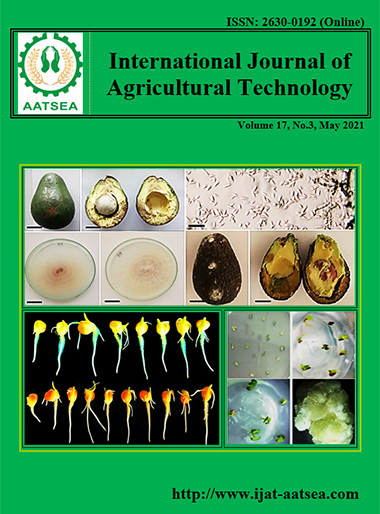Molecular identification of Anaplasma ovis and Anaplasma marginale in Sheep using PCR-RFLP method
Main Article Content
Abstract
Anaplasma is a protozoan blood in livestock such as cattle, goats and sheep. This pathogen leads to anaplasmosis, which is tick-borne disease, production loss and high costs due to disease prevention. Therefore, it is necessary to investigate the epidemiology of Anaplasma of livestock. The results demonstrated that the semi-nested-PCR product was approximately 120 bp. The restriction endonuclease Bst1107I only recognized the sequence (GTATAC) in semi-nested PCR product of A. marginale and cut the sequence at the position 68. However, the restriction endonuclease was not able to cut the semi-nested PCR product of A. ovis at the same position because of the different sequence (GTACGC). The prevalence of A. ovis and A. marginale infection in sheep at Sa Kaeo Province was 3.66% (3/82) and 1.22% (1/82), respectively. The overall prevalence of Anaplasma infection in sheep was 7.32% (6/82). From this result, the PCR-RFLP method could be used to isolate A. ovis and A. marginale using this technique with high specificity and safe time to identify both types of infection
Article Details

This work is licensed under a Creative Commons Attribution-NonCommercial-NoDerivatives 4.0 International License.
References
Ahmadi-Hamedani, M., Khaki, Z., Rahbari, S., Kazemi, B. and Bandehpour, M. (2009). Molecular identification of anaplasmosis in goats using a new PCR-RFLP method. Iranian Journal of Veterinary Research, 10:367-372.
Altay, K., Dumanli, N., Holman, P. J. and Aktas, M. (2005). Detection of Theileria ovis in naturally infected sheep by nested PCR. Parasitology, 127:99-104.
Chomczynsky, P. and Sacchi, N. (1987). Single-step method of RNA isolation by acid guanidinium thiocyanate phenol choroform extraction. Analytical Biochemistry, 162:156-159.
Fuente, J. D. L., Ronald, A., Bussche, V. D., Jose, C., Garcia, G., Rodriguez, D., Miguel, A. G., Garcia, M. A., Guglielmone, A. A., Mangold, A. J., Passos, L. M. F., Ribeiro, M. F. B., Blouin, E. F. and Kocan, K. M. (2002). Plylogeography of new world isolates of Anaplasma marginale based on major surface protein sequences. Veterinary Microbiology, 88:275-285.
Gisele, M. B., Carlos, A. N. R. and Flábio, R. A. (2014). Molecular diagnosis of Anaplasma marginale in cattle: quantitative evaluation of a real-time PCR (Polymerase Chain Reaction) based on msp5 Gene. Pesquisa Veterinária Brasileira, 34:29-33.
Hamou, S. A., Rahali, T., Sahibi, H., Belghyti, D., Losson, B., Goff, W. and Rhalem, A. (2012). Molecular and serological prevalence of Anaplasma marginale in cattle of North Central Morocco. Research in Veterinary Science, 93:1318-1323.
Kaewhom, P. (2017). The Prevalence of Theileria spp. of Goat in Watthana Nakhon District, Sa Kaeo Province. Journal of Mahanakorn Veterinary Medicine, 12:57-66.
Kaewhom, P., Jaroensuk, J., Rattanachitthawat, S., Poolsamran, P., Lukkananukool, A., Srikijkasemwat, K., Mitchaothai, J. and Ard-rugsa, T. (2017). The Prevalence of Anaplasma marginale of goats in Watthana Nakhon District, Sa Kaeo Province. Agricultural Science Journal, 48:968-974.
Kaewhom, P. (2014). Molecular detection of Trypanosoma evansi among cattle and buffaloes blood. Journal of Mahanakorn Veterinary Medicine, 9:49-61.
Kursat, A., Dumanli, N. and Aktas, M. (2007). Molecular identification, genetic diversity and distribution of Theileria and Babesia species infecting small ruminants. Parasitology, 147:161-165.
Marvat, E. I. R., Ali, A. F. and Hamied, A. (2013). Epidemiological studies, molecular diagnosis of Anaplasma marginale in cattle and biochemical changes associated with it in Kaliobia governorate. American Journal of Infectiouses and Microbiology, 1:46-49.
Restic, M. and Watrach, A. M. (1963). Anaplasmosis. Part VI. Studies and a hypothesis concerning the cycle of development of the causative agent. American Journal of Veterinary Research, 24:267-276.
Rymaszewska, A. and Grenda, S. (2008). Bacteria of the genus Anaplasma-characteristics of Anaplasma and their vectors: a review. Veterinarni Medicine, 11:573-584.
Saetiew, N., Simking, P., Saengow, S., Kurajog, B., Yimming, B., Saeng-chuto, K., Chimnoi, W., Kengradomkij, C., Yangtara, S., Suksai, S., Thaprathom, N., Seneemanoma, C., Penghirun, K., Desquesnes, M., Herder, S., Morand, S. and Jittapalapong, S. (2014). Seasonal effect on Anaplasma marginale infections of beef cattle in previously flooding areas. Proceedings of the 52nd Kasetsart University Annual Conference: Animal, Veterinary Medicine, Nakhon Pathom, Thailand, 4-7 February, 2014:267-277.
Shebish, E., Vemulapalli, R. and Oseto, C. (2012). Prevalence and molecular detection of Anaplasma marginale, Babesia bovis and Babesia bigemina in cattle from Puntarenas Province, Costa Rica. Veterinary Parasitology, 188:164-167.
Taweenan, W. (2004). Ruminant medicine: Important parasites in dairy cows. Department of Pathobiology, Faculty of Veterinary Medicine, Khon Kaen University.
Yousefi, A., Rahbari, S., Shayan, P., Sadeghi-dehkordi, Z. and Bahonar, A. (2017). Molecular detection of Anaplasma maginale and Anaplasma ovis in sheep and goat in west highland pasture of Iran. Asian Pacific J Tropical Biomedicine, 7:455-459.


